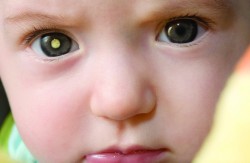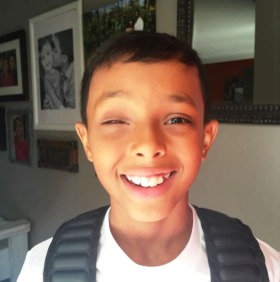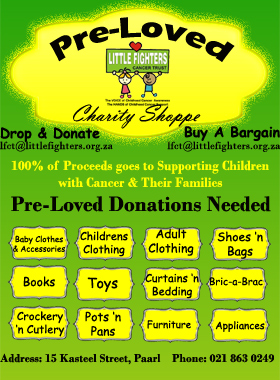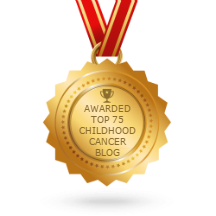Living With Retinoblastoma ~ Part III
 Today we continue with Part III of Living With Retinoblastoma, a fast growing eye-cancer which affects babies and young children.
Today we continue with Part III of Living With Retinoblastoma, a fast growing eye-cancer which affects babies and young children.
Today’s post will cover living with a prosthetic or “special” eye, mainly from the child’s point of view, and with some good pointers for parents to help their Little Fighters to come to terms with their new special eye, physically and psychologically.
Retinoblastoma affects about 1 in 15, 000 live births, and an estimated 9,000 children develop the cancer globally each year. These posts cover living with retinoblastoma for those who have either had treatment for or have been through enucleation (surgical removal of the eye).
The reason for the posts is to help both children with retinoblastoma and their parents cope for the next few years to the rest of their lives…
The Young Child Living With a Special Eye
Young children need to feel they are active participants in the care of their special eye. You can help your child find his or her own unique strategies to cope with their special eye, to embrace it and live well with it.
Use the techniques below as a guide. Ask a child life specialist at your hospital for support if you feel you need additional help.
Touch Through Play
For very young children with retinoblastoma, the need to routinely touch and examine the eye area can be a stressful experience.
A good method of providing positive sensory experiences that allow your child to become more familiar with touch is to use play. This will sensitise and calm him/her, enabling necessary care of the special eye.
Using games like peek a boo, in which you take turns gently touching each other’s faces around the eye area, brows and cheeks, works very well with young children. This provides positive touch, without any manipulation or need to remove the special eye.
Body-part songs (Head, Shoulders, Knees & Toes, for instance) often include the eye area. Including them in daily play-times may facilitate more positive touch experiences in and around the eye.
Encourage your child to play dress-up games with glasses, and activities using binoculars or viewfinders. These are all excellent playful ways for them to touch the eye area with objects, without touching the special eye itself.
Through this sensitisation, children become experienced with contact in and around their eye. As a result, they are calmer and more familiar with the sensations when care of the eye is required.
Distraction
Distraction games and toys are also an excellent way to support young children during visits to the eye doctor or ocularist.
Used in hospital and at home, distraction toys and activities reduce stress, increase cooperation, and offer much needed fun to children coping with procedures and illness.
When selecting a distraction method, allow your child to make choices whenever possible to ensure they feel a sense of involvement and control. You can purchase distraction items, but many distraction activities can also be created at home
Activities can include blowing bubbles, singing favorite songs, playing with cause and effect musical toys, and listening to story books on an MP3 Player.
Bubbles, pinwheels, feathers, party blowers, instruments (kazoo, harmonica, recorder) all promote deep breathing. This helps the body relax and may make the procedure go by faster.
You can encourage your child to “blow the pain away”. Have a contest to see who can blow the hardest or longest, or who can blow the biggest bubble.
Practice breathing and blowing together when your child is not having a procedure done. Deep breathing is an excellent tool for managing stress and anxiety in everyday life.
Waving a “Magic Wand” filled with water, sparkles or confetti can focus your child’s attention on something other than the procedure. You can use the wand in many ways: let your child watch the sparkles move and float in the wand; teach them to wave the wand and use their imagination to block the pain, or go on a magical adventure to a favourite place.
Story/Activity Books are books that include bright pictures, repetitions the listener can join in with, different textures, sounds or pop up are fun for infants and younger children. Older children may enjoy books that offer a challenge, like searching for something in the picture, or a puzzle.
Open-ended story books encourage children to use their imagination. Familiar or family favourite books are a welcome source of calm and comfort.
Distraction can become easily portable and changeable with hand held games, video games, computer, TV and mobile phones. Use familiar favourites or new movies and games.
Music can relax and/or distract a child during a procedure. Use CD, MP3 player/Ipod, music box or singing songs. Encourage your child to sing along, hum, click his tongue, clap or tap his feet to the music.
Stress balls or squeezable toys such as stuffed animals or shapes and foam items are a great place to transfer pain, anger or nervous energy.
Infant Massage
Positive, relaxing touch can also help children cope with medical appointments. Gentle strokes on the forehead, face and neck can sooth and comfort an upset child. The three sets of photos below demonstrate simple baby massage strokes you can use with your child.
Some children may prefer touch on an area away from the face. Hand, feet and back strokes are recommended as calming forms of positive touch away from the eye.
The Older Child Living With a Special Eye
Older children need to be actively engaged and supported in living with a special eye. You can help your child find his own unique strategies to cope with his special eye, to embrace it and live well with it.
Use the techniques below as a guide. Ask a child life specialist at your hospital for support if you feel you need additional help.
Older children need to know what is happening and what will happen next. You can reduce your child’s anxiety by giving accurate age-appropriate information about each step in the procedure relating to his special eye.
Give your child choices, wherever possible. This will validate his or her feelings and foster belief in his/her ability to make decisions about their own medical care. Some examples include questions such as:
“Would you like to remove your special eye yourself or would you like Daddy to do it?”
or
“Would you like to sit on the examination chair by yourself, or on Mommy’s lap?”
As children grow older and more aware of their special eye, they may experience incidences or embarrassment about it. They may also be fearful of these potential incidences, even if they haven’t actually ever occurred.
Social inclusion is very important to children. Fostering confidence and pride about your child’s special eye will help him/her be successful in his/her interactions with peers and adults in public.
It may be a good idea to help your child to prepare and practice some basic responses, or scripts of what to say about the special eye when people ask. This will promote mastery and ensure that your child will feel comfortable responding when he is at school or elsewhere, without your support.
Keep these scripts simple by including “just the facts”. This will free your child to choose whether he/she explains more, if he/she wants to and feels comfortable doing so.
An example might be “my eye was sick so the doctor took it away to make me better, and gave me a special pretend/magic eye instead”
Creating a self-published book is an excellent activity to help children feel proud and empowered about their special eye. An “I am….” or an “I can….” Book depicts all the wonderfully positive qualities, abilities and strengths of one child.
This encourages your child to identify and illustrate all sorts of great things about him or herself, helping to boost his/her self-esteem and confidence.
When There Is No Eye
Most children experience at least one period of time when they cannot wear a special eye.
For 4-10 weeks after enucleation, most children do not have an artificial eye because the special eye is not made until the eye-socket has healed. This ensures the best possible fit.
 Sometimes a child is not able to wear a special eye due to infection or an implant exchange surgery.
Sometimes a child is not able to wear a special eye due to infection or an implant exchange surgery.
Many children will not receive a special eye after the removal of their cancerous eye. either because artificial eyes are not available or are too expensive. This means the eyelids will remain closed, or almost closed, and the lids will lay flat.
There are a number of important considerations to make about your child’s coping, and your own coping as a parent when there is no eye.
It is important to remember that the eye was removed to help your child be as healthy as possible, and give him/her the best chance of surviving the cancer. Focusing on the positive – the health and well-being of your child – is your priority.
Your medical team will discuss strategies for the regular care and cleaning of the socket to ensure the tissue inside it remains healthy.
Some parents and families are deeply distressed that their child looks different, with one eye closed. Different cultures have different beliefs and responses to children who are missing an eye, or look different.
Many parents find it helpful to have a standard prepared “script” or statement to say when strangers or friends ask what happened to the child’s eye. Your family can decide how much information you would like to share with others.
For example:
“My son/daughter had cancer in their eye. Their eye was removed as part of the cancer treatment to save their life.”
Many children who have their sick eye removed as an infant are unaffected by the lack of special eye as they grow older, since they have only known life without the eye.
However, some children feel self-conscious or uncomfortable about the fact that they look different from their peers. They may face comments from others about their eye.
Again, it is helpful to prepare scripts that explain what happened and the reason the eye looks different.
For example:
“When I was little my eye was sick and needed to be removed”
These statements can be enhanced by adding:
“Even with only 1 eye I can do everything that you can do. I can run fast, I can draw beautiful pictures, I can ride a bike……etc…”
Children who are self conscious or uncomfortable with appearing different may benefit from writing an “I am book” or an “I can book” that includes facts about all the amazing things they can do and photographs or drawings for each statement.
Here are some examples:
- I am a big sister.
- I am the tallest in my class.
- I am a daughter.
- I am a cousin.
- I am a cancer survivor.
- I am a good painter.
- I am an eager student.
- I can jump really high.
- I can cook eggs all by myself.
- I can swim.
- I can sing beautiful songs.
- I can do anything you can do!
Psychological Support
From birth on, children constantly learn and develop as they navigate different experiences. With the right information, attention and support, they can learn to do anything. Children are built to survive!
Each infant or child has a unique experience of retinoblastoma diagnosis, therapy and life after treatment. They have different feelings and reactions. There is no right or wrong response.
Each child’s experience is “their” experience. For many, retinoblastoma and its treatment is the only life-experience they have. Our job as adults is to support them through that experience.
Your child needs lots of support from family, friends and from others in their immediate surrounds in dealing with treatment and life after retinoblastoma. He/she needs words of compassion, love, hope, and encouragement. There is much you can do to help him along the way.
Coping With Difference
Children, and sometimes adults too, can be insensitive to people who are “different” from them.
Baldness and facial differences fall into this category. Children with retinoblastoma can experience ridicule from classmates and even strangers, which is unfair and unkind, but unfortunately it does sometimes happen.
Coping with difference can be hard for children. There are many ways you can help your child navigate the world and embrace life with a healthy perspective.
Help Your Child Learn About Difference
Around the age of five, children start to become aware of their appearance and the appearance of others; they adapt and change to fit the environment around them.
Adults and children, friends and strangers, react to physical differences all the time. Unfortunately these reactions can teach children to be embarrassed, ashamed or upset about themselves and their perceived differences. On the flip-side, they can learn acceptance, develop confidence and achieve peace.
If you are hesitant or lack confidence in handling your child’s prosthetic eye, he/she will learn to be hesitant and lack confidence. If you are anxious or fearful about lifelong testing and checking for second cancers or relapse, he/she will also learn anxiety and fear.
Consider how you respond to the differences of others, and to negative experiences in your life. The more you embrace difference and learn to manage change, disappointment and loss, the more you will promote effective coping to your child.
Help Your Child Talk to Others
No parent can be all places at all times to offer help and explanations. You cannot always protect your child from the reactions and comments of others. Help him to help himself at these times.
Give him scripts of appropriate responses he feels comfortable saying. Practice them at home so he builds confidence. Some examples are:
“Yes, my face looks a bit different. That’s because I have a special pretend eye.”
“My eye looks different because when I was a baby I had an illness/I was sick with something called retinoblastoma/cancer.”
“These tubes on my chest are for medicine to go into my body. The medicine helps my body fight retinoblastoma/cancer.”
If your child is uncomfortable sharing information with others, work with him on phrases such as:
“Yes, I look different – Just like you look different from me.”
“My eye is different, but it hasn’t stopped me being an expert at… (piano, singing, skating, swimming, football, Pokeman, computers…)”
Enable Others to Support Your Child
Talk to your child to find out if he is comfortable sharing his experience. If he is happy for you to do so, explain to other people in his life that he has cancer and is undergoing therapy, and that his hair may fall out, or that he has an artificial eye.
Talk to friends, neighbours, your child’s school (teachers and counselors). People are often more mindful of what they say, and how they respond, when they know and understand the situation.
Encourage other parents to talk with their children about differences, about cancer and the associated hair loss. Communication is key to helping others understand what your child is going through in battling cancer, losing his hair and/or his eye.
Support and Encourage Your Child
Be aware of the psychological outcome eye removal and other cancer therapies can have on young children. Psychological adaptation to eye removal surgery in early childhood is generally considered good. Still, many children have concerns about their appearance, or about handling the eye.
Many children have chemotherapy to save their sight, or because pathology of their removed eye showed a high risk for recurrence. They may have a concern about hair-loss, and dealing with peers’ responses to this.
Children may struggle with the side-effects of treatment, isolation from friends and familiarity, as well as the emotional trauma of repeated procedures and hospitalisations. These experiences may impact their interaction with the regular world, both during treatment and for many years after the treatment ends.
You can do a lot to support and encourage your child through treatment and beyond.
Throughout your child’s life, provide positive, supportive and encouraging words of praise about all of his/her abilities, interests and experiences. This will help build his/her self-esteem, give him/her confidence about him/herself and confidence to try new things.
Let him/her know how proud you are of all their little successes, and how proud you are when he/she copes with negative experiences too. Talking to your child about his/her strengths and abilities is important all the time, not just when he/she is facing other people’s comments or insensitive actions.
When your child is unsuccessful at something, or has a negative experience, be there to support him/her. Help him/her to cope, grow and learn from that experience. Protecting your child from all negative experiences does not give him/her a chance to learn resilience.
Know Your Child’s Feelings
Talk to your child. Listen, and hear what he/she has to say about his/her experiences. Be compassionate and understanding with him/her. If he/she is upset or uncomfortable about something, ask him/her what he/she thinks he/she needs to help him/her feel better.
Some children experience great distress and even depression about how others perceive them and their differences. If you are concerned, or you don’t feel comfortable or capable supporting your child yourself, please seek help.
You can ask for assistance from your child’s oncological team, a social worker, your family doctor, a psychologist or psychiatrist. Even if the person you ask is unable to help you directly, they will be able to refer you to a professional who can help your child cope better.
Continued in Part IV
Posted on 13 October, 2016, in Advice & Tips, Blog, Videos and tagged cancer, cancer awareness, cancer cells, cancer treatment, childhood cancer, Children with Cancer, enucleation, LFCT, Little Fighters Cancer Trust, paediatric cancer, Pediatric cancer, pediatric cancer awareness, Retinoblastoma. Bookmark the permalink. Leave a comment.















Leave a comment
Comments 0